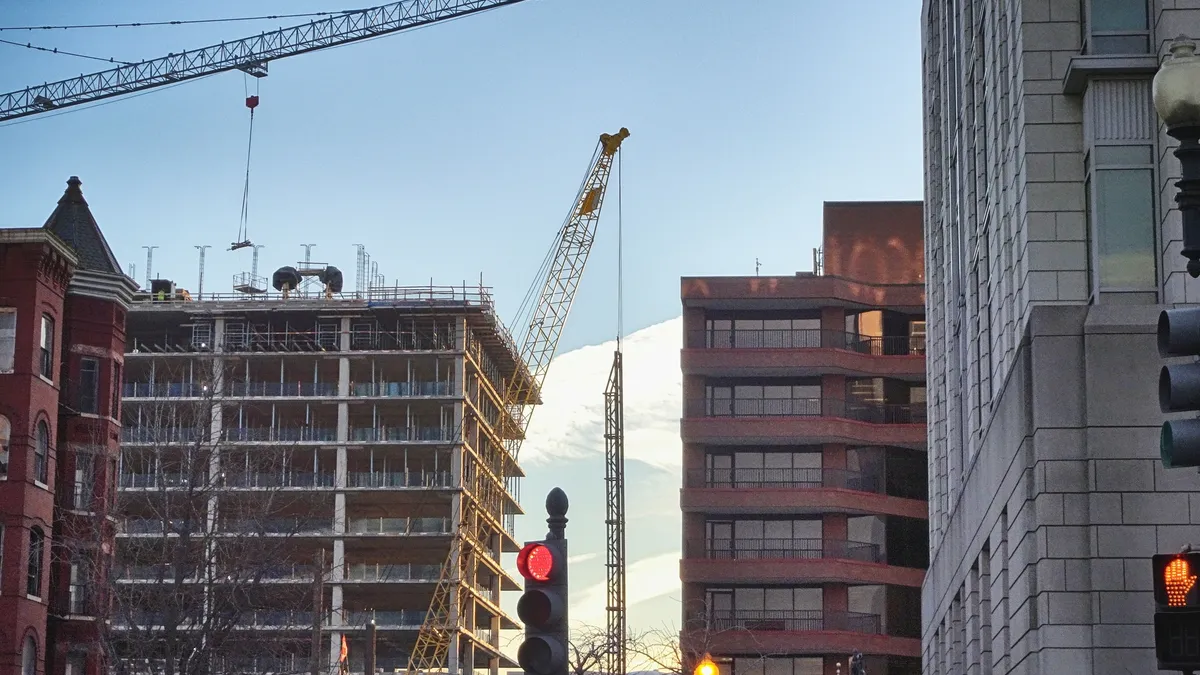Dive Brief:
- Washington, D.C., Mayor Muriel Bowser released highlights of the forthcoming Downtown Action Plan in February, laying out a recommended plan for the city to spend $400 million over the next five years to revitalize its slumping downtown.
- The plan calls for measures to encourage new housing construction in downtown D.C., including streamlined construction permitting processes, amendments to federal building height laws and a simplified process for converting office space into housing.
- The plan also aims to improve streetscapes, parks, open spaces and public safety. It calls for the expansion of the district’s Vitality Fund, which incentivizes businesses in certain sectors to relocate to, expand in or stay in the district.
Dive Insight:
Downtown Washington, D.C., never fully recovered from the COVID-19 pandemic, when many of the office workers who anchored its economy moved to remote work.
The downtown generates nearly a quarter of D.C.’s revenue, but annual tax revenue generated in the busy district has fallen by $243 million since 2019 — a downward trend that could cost D.C. another $193 million over the next five to 10 years without intervention, according to the new action plan summary. With intervention, annual revenues generated by the downtown are projected to grow $300 million by 2033 — slightly above pre-pandemic levels.
The plan is “addressing the moment in time that we’re in,” said Gerren Price, president and CEO of the DowntownDC Business Improvement District, one of the groups that spearheaded the plan’s development. The effort will ultimately bring a renewed sense of vibrancy to the downtown, as well as more tax dollars and the healthy economic contribution the city has historically expected from the area, he added.
A national trend
D.C. is one of many cities looking to revitalize downtown areas following the pandemic, joining San Francisco, Boston, Minneapolis, Los Angeles and Denver.
Last year, Bowser set a goal of adding 100,000 new residents to the city’s downtown by converting office space into residential housing. But so far, such conversions have been an “incredibly challenging and costly proposition,” Price said.
The plan recommends making it easier to complete such conversions via flexible building codes and energy standards and by automatically adjusting multifamily development tax classifications.
Price said D.C.’s stringent building height requirements have held back conversions, and “modest changes” to those requirements would make projects more viable and allow affordable housing to be built higher in some areas. However, he emphasized that the plan doesn’t advocate for skyscrapers that block views of the national monuments. Any changes to the Height Act would need federal review and congressional approval.
D.C. plans to support residential population growth downtown by creating a grant program that encourages amenities such as grocery stores, daycare, parks and senior services.
The Downtown Action Plan calls for changes in the way people move through downtown D.C. by creating a long-term transportation plan, implementing a dynamic pricing program for on-street parking and expanding sidewalks. Long-term, the plan recommends completing Vision Zero projects, creating pedestrian zones, modernizing Metro stations, expanding tree canopy and integrating multimodal mobility systems through key corridors.
Comprising 140 blocks, downtown D.C. is not a monolithic area, Price said. The plan attempts to forge identities for different neighborhoods in the downtown and create spaces that “people want to be in and continue to attract new people,” he said.
Capital One Arena — and a “Plan B”
Amid proposals to move the Washington Capitals and Washington Wizards professional sports teams from downtown D.C. to Northern Virginia, the downtown plan recommends that the city continue negotiations to try to keep the teams at Capital One Arena. But the document also details using the Smithsonian National Portrait Gallery across the street from the existing Capital One Arena as an anchor to turn that area into an arts and culture destination. The plan still encourages the development of a "Plan B" for the area in the event the teams do move.
To help accomplish that, Price said the plan would entail building dynamic public spaces around the Portrait Gallery, a popular tourist attraction. Changes include transforming one neighboring street into a busy area with retail and outdoor dining and better connecting the area to other cultural institutions and nearby shopping anchors, he said.
To address public safety concerns that have hampered the downtown in recent years, the plan proposes boosting a safe commercial corridor grant program, developing and passing legislation targeting organized retail theft, and building new “neighborhood safety centers” where first responders like police and mental health professionals can co-locate.
The full version of the plan is slated for release in May. The $400 million plan would need to be approved by the D.C. Council, Price said. According to the plan summary, the city will create a Downtown Action Plan Committee and an implementation team comprising city officials and downtown stakeholders, which will set a budget, create a full implementation plan and serve as a liaison to universities located downtown.










